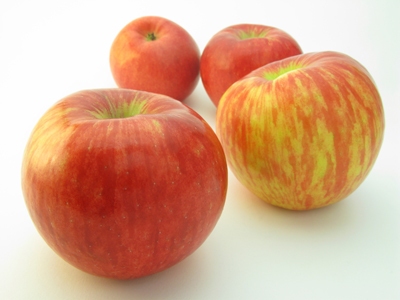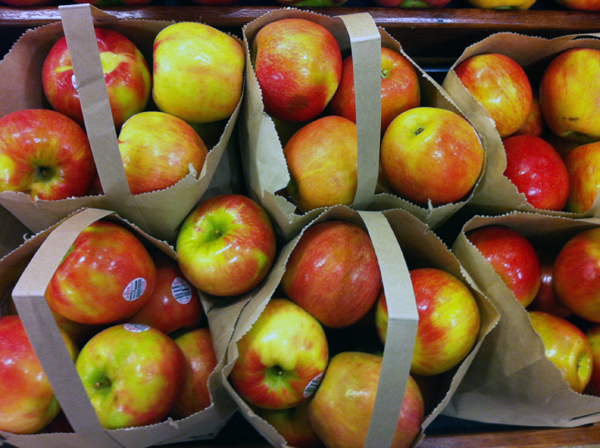I walked in to the grocery store a couple of weeks ago to grab a few things and ended up grabbing a few things not on my list. Who doesn’t? I stopped dead in my tracks when I saw the front fruit display had traded peaches for Honeycrisp apples. After months and months without eating any apples, I was beside myself with excitement as I loaded up four softball-sized apples at $2.99 per pound.
Yep. I paid a three dollar per-pound price for a piece of fruit. And so have millions of other people. I am part of the reason the Honeycrisp craze has grown in to a full blown obsession rivaling only those who camp out for the first pumpkin spiced coffee of the season. I don’t eat any other kind of apple, and until a few years ago it had been several years since I’d even touched one. Honeycrisps are unlike any apple you’ve ever tried.
The Honeycrisp was developed at the University of Minnesota’s apple breeding program in 1960. It was a cross of the Macoun and Honeygold, a hybrid of the two apples that took more than 30 years to move to market. Between 1960 and 1991, the apple that is now known as the Honeycrisp was identified, tested, and introduced to market in 1991. That was 20 years ago. So where has this divine piece of fruit been hiding? I asked David Bedford, a research scientist and lead apple breeder at the University of Minnesota. This is Mr. Honeycrisp.
Once the Honeycrisp was released in 1991, Bedford explained it was a very grassroots effort to get the apple out there. They had to sell the seeds to the nurseries, who then sold saplings to the orchardists, who then had to plant and grow the trees. These aren’t like tomato vines, they take time, years in fact. Once the Honeycrisp trees were planted they had three to five years before they were fruit bearing.
An apple with no marketing budget and just some excitable word of mouth has grown to be the fifth most grown apple in the U.S, according to Bedford. “It’s a hometown kid without much promotion.” The apple really took off and joined the mainstream, Bedford explained, after Washington state growers got a hold of it. “Sixty percent of apples in the country are grown in Washington,” he said. “When they get behind something, you see it go mainstream.”
The Honeycrisp doesn’t need a marketing budget when it tastes like this. It sells itself half way through the first bite. That was the goal of Honeycrisp before it had a name and before it was even a seed. The 105-year-old apple breeding program at the University of Minnesota had two goals – for apples to survive cold winters and eating quality. Bedford explained that, “it had to be an apple consumers can enjoy eating.” They hit this one out of the park.
Bedford, like myself, admitted to not liking apples as a kid, noting the Red Delicious was his least favorite. Mine as well. “Those dark red mealy things,” he called them. How could anyone enjoy apples when that’s all you’ve had? But the Honeycrisp, that’s an apple worth sinking your teeth into. It’s the kind of apple where you don’t mind the juices running down your chin because it’s just that good.
honeycrisp apples > every other apple
— Ocianna Gregg(@shanngregg) October 15, 2024
Every time the popularity of the Honeycrisp came up in our conversation Bedford just laughed, a very knowing but fairly humble laugh. I told him I had a $3 Honeycrisp sitting in my bag at that moment, and I did. When asked why the apple is so darn popular, he said, “That’s simple – texture and flavor.”
Real talk: why do apples other than Honeycrisp even exist? STOP TRYING, other apples.
— Amy Estes (@amy_estes) October 10, 2024
At the time the Honeycrisp was in development, he explained that you either had soft and mealy apples or they were hard, crisp, and dense. “When Honeycrisp came along we had to redefine texture. We had to break crisp out. Honeycrisp is not a hard apple, it’s truly crisp,” Bedford explained.
He said apples are actually checked for hardness by pressing a rod in to the center and measuring for pounds of pressure. A Granny Smith or Pink Lady can sustain 22 pounds of pressure; the Honeycrisp only about 13 or 14 pounds.
What the Honeycrisp did was redefine how the word ‘crisp’ was used in conjunction with apples. Anyone who has eaten one knows what he’s referencing – that breaking sound when your teeth slide through the juicy flesh of the apple. “If I’m in a room with someone who’s biting in to an apple, I can tell you whether or not it’s a Honeycrisp just by hearing the bite,” he said. That’s pretty impressive ears, a pretty impressive apple, or probably a little of both.
He describes the Honeycrisp as “explosively crisp” and talks about how the “juice flies” when you take a bite. “It’s a quantum leap forward in what we’re studying, and that’s what the Honeycrisp’s most unique contribution is to apples.” So much so that in 2006, Better World Report named the development of the Honeycrisp as a top 25 innovation for the decade.
This apple has a spectacular balance of sugar (or sweetness) and acidity, which Bedford says is a very good flavor that lends to “a lot going on in your mouth,” but it may very well be a better apple for you over all. I asked Bedford if the Honeycrisp was nutritionally superior to other apples, but he said it wasn’t something he was aware of. “I would love it to be true.”
According to LiveStrong.com, the Honeycrisp is only a hair more nutritious than your average apple, with 80 calories, 22 grams of carbohydrates, 5 grams of fiber, and 17 grams of sugar. That same 154 gram (or five ounce) apple at CalorieKing.com has 80 calories, 21 grams of carbohydrates, 3.7 grams of fiber, and 16 grams of sugar.
“What the Honeycrisp has contributed to national health is that people are more likely to eat something they like,” said Bedford. In other words, people are more likely to have that apple a day and keep the doctor away when they’re eating an apple that tastes great, has a good mouthfeel, and is enjoyable to eat.
While inspecting the nutritional value of these premium apples, we had to know, are organic varieties a possibility? Bedford explained that the Honeycrisp is naturally resistant to the main disease that apples are sprayed for, therefore making it an easier apple to grow organically. And with all the talk about GMOs going on, I had to know if my favorite apple was going to need a label, but Bedford assured me it would not. He said they are “absolutely not” a GMO and explained. “Every apple in the world is a hybrid – man-made or occurring by bees. No apple exists without cross pollination.” While Honeycrisp was developed in a lab, its genes were not manipulated, therefore clearing it from any GMO concerns.
I’m saving up to buy a Honeycrisp apple.
— Jack Sh*t (@JackSht) October 1, 2024
These apples aren’t cheap. As I mentioned, and many a tweet shows, a single Honeycrisp apple set me back a whole $3 dollars last week when I managed to take one of the bigger ones from the bin. When you consider all the research, development, and the shipping from what is likely Washington state, the price adds up on this special fruit. Personally, I don’t buy any other apples all year long, so it’s worth the splurge to enjoy one that I’ll actually savor and eat.
If you’re a diehard Honeycrisp fan, then Bedford says to keep an eye out for the apple’s first offspring. He says the SweeTango, another University of Minnesota apple breed, is in its infancy and about two years from mass market availability. “It has the Honeycrisp texture, but an even more intense flavor.” I’m sold!
Also Read:

